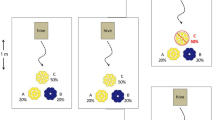Summary.
For butterflies to be efficient foragers, they need to be able to recognize rewarding flowers. Flower signals such as colours and scents assist this recognition process. For plant species to attract and keep butterflies as pollinators, species-specific floral signals are crucial. The aim of this study is to investigate foraging responses to floral scents in three temperate butterfly species, Inachis io L. (Nymphalidae), Aglais urticae L. (Nymphalidae), and Gonepteryx rhamni L. (Pieridae), in behavioural choice bioassays. The butterflies were allowed to choose bet-ween flower models varying in scent and colour (mauve or green). Flowers or vegetative parts from the plants Centaurea scabiosa L. (Asteraceae), Cirsium arvense (L.) (Asteraceae), Knautia arvensis (L.) (Dipsacaceae), Buddleja davidii Franchet (Loganicaeae), Origanum vulgareL. (Lamiaceae), Achillea millefolium L. (Asteraceae), and Philadelphus coronarius L. (Hydrangiaceae) were used as scent sources. All visits to the models — those that included probing and those that did not — were counted, as was the duration of these behaviours. Both flower-naive and flower-experienced (conditioned to sugar-water rewards, the colour mauve, and specific floral scents) butterflies were tested for their preference for floral versus vegetative scents, and to floral scent versus colour. The butterflies were also tested for their ability to switch floral scent preferences in response to rewards. Flower-naive butterflies demonstrated a preference for the floral scent of the butterfly-favourable plants C. arvense and K. arvensis over the floral scent of the non-favourable plants Achillea millefolium (Asteraceae), and Philadelphus coronarius cv. (Hydrangiaceae). Most of the butterflies that were conditioned to floral scents of either C. arvense, K. arvensis, or B. davidii readily switched theirfloral scent preferences to the one most recently associated with reward, thus demonstrating that floral scent constancy is a result from learning. These findings suggest that these butterflies use floral scent as an important cue signal to initially identify and subsequently recognize and distinguish among rewarding plants.
Similar content being viewed by others
Author information
Authors and Affiliations
Additional information
Received 2 September 2001; accepted 9 September 2002.
Rights and permissions
About this article
Cite this article
Andersson , S. Foraging responses in the butterflies Inachis io, Aglais urticae (Nymphalidae), and Gonepteryx rhamni (Pieridae) to floral scents. Chemoecology 13, 1–11 (2003). https://doi.org/10.1007/s000490300000
Issue Date:
DOI: https://doi.org/10.1007/s000490300000




